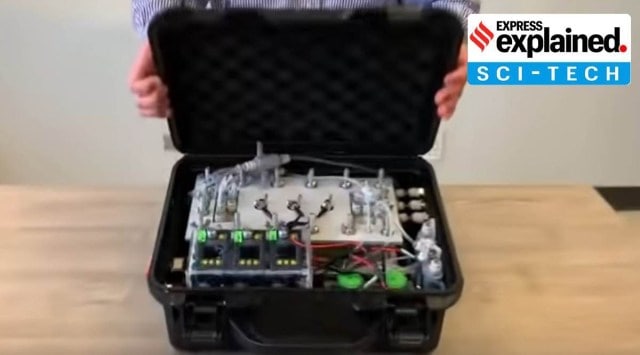Explained: A portable device that turns seawater into drinking water, without using filters
While other portable desalination units that require water to pass through filters, this device utilises electrical power to remove particles from drinking water.
 The suitcase-sized device uses electrical power to remove particles from water. MIT News/Video Grab
The suitcase-sized device uses electrical power to remove particles from water. MIT News/Video GrabMassachusetts Institute of Technology (MIT) researchers have developed a portable desalination unit, weighing less than 10 kg, that can remove particles and salts to generate drinking water.
WHAT IT DOES: The suitcase-sized device requires less power to operate than a cell phone charger. It can also be driven by a small, portable solar panel, which can be purchased online for around $50 (about Rs 3,800 at current exchange rates), MIT said in a news release. It said the device automatically generates drinking water that exceeds World Health Organization (WHO) quality standards. The device runs with the push of one button.
While other portable desalination units that require water to pass through filters, this device utilises electrical power to remove particles from drinking water. Eliminating the need for replacement filters greatly reduces the long-term maintenance requirements. This, the release said, could enable the unit to be deployed in remote and severely resource-limited areas. It could also be used to aid refugees fleeing natural disasters or by soldiers carrying out long-term military operations, it said.
The researchers have described the device in the American Chemical Society journal Environmental Science & Technology.
“We worked for years on the physics behind individual desalination processes, but pushing all those advances into a box, building a system, and demonstrating it in the ocean, that was a really meaningful and rewarding experience for me,” the release quoted senior author Jongyoon Han, a professor of electrical engineering and computer science and of biological engineering, as saying.
HOW IT WORKS: The unit relies on a technique called ion concentration polarisation, which was pioneered by Han’s group more than 10 years ago, the release said. Rather than filtering water, the process applies an electrical field that causes positively or negatively charged particles — including salt molecules, bacteria, viruses — to be repelled as they flow past. The charged particles are funnelled into a second stream of water that is eventually discharged. The process removes solids, allowing clean water to pass through the channel.
PAPER: ‘Portable Seawater Desalination System for Generating Drinkable Water in Remote Locations’, Junghyo Yoon et al, Environmental Science & Technology. pubs.acs.org/doi/10.1021/acs.est.1c08466
Source: MIT News
- 01
- 02
- 03
- 04
- 05






































